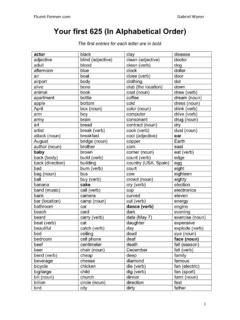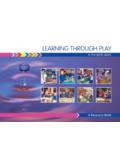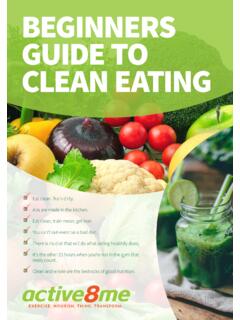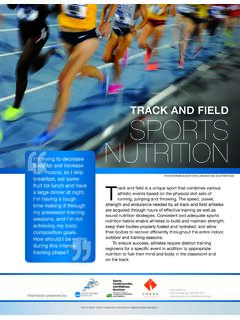Transcription of Healthy eating with haemodialysis - Queensland Health
1 This is a consensus document from Dietitian/ Nutritionists from the Nutrition Education Materials Online, "NEMO", team. Disclaimer: Developed: June 2019 Copyright: Due for review: June 2021 My Nutrition My Nutrition Healthy eating for haemodialysis haemodialysis removes water and waste products from your blood by running it through a filter. It does not fully replace the role of the kidneys. There are many things about your food and drinks that are important to consider. This handout will give you information on the following: Healthy eating : This is important to help you manage your weight Protein: This is important to keep you Healthy and strong Potassium: You may need to reduce potassium in your diet Salt (sodium): You may need to cut down salt in your diet Phosphate and phosphate binders (tablets): You may need to cut down phosphate in your diet and binders may be needed when you eat food Fluid: Cutting back on fluid is important to protect your heart Diabetes: eating well for your diabetes and monitoring your blood sugars is still important while you are on dialysis Heart Health : It is recommended to have unsaturated fats in your diet Healthy eating The amount of food you need to eat may increase when you start dialysis.
2 It is important to eat a variety of different foods. eating enough food is important because it will: Stop you losing weight without trying Stop you gaining too much weight Give your body energy to do the activities you enjoy Help your body use protein for building muscles and tissues Protein The amount of protein you need to eat may also increase when you start dialysis. Your Dietitian can work out how much protein you need. Protein in your diet helps to: Protect your body from illness and infection Help your body build muscles and repair tissue Keep you feeling strong and Healthy eating protein-rich foods at every meal can make it easier for you to eat all the protein you need. My Nutrition This is a consensus document from Dietitian/ Nutritionists from the Nutrition Education Materials Online, "NEMO", team. Disclaimer: Developed: June 2019 Copyright: Due for review: June 2021 My Nutrition My Nutrition The best sources of protein are: Meat, including red meat, chicken and fish Eggs Milk and milk products custard, yoghurt and cheese Tofu and legumes eg kidney beans, chick peas and lentils You may need to see the Dietitian if: You are losing weight without trying Have poor appetite or nausea You are unable to eat enough Are underweight Note: You may need to take nutritional supplement drinks that are high in protein and energy.
3 Your Dietitian can recommend a drink which is best suited to you. Potassium If your kidneys are not working properly, potassium may build up in your blood. There are usually no symptoms of a high potassium level. Regular blood tests will check your potassium level. You can manage your potassium levels by some of the foods you eat. High levels of potassium are very dangerous, and may cause your heart to beat irregularly and even stop beating. Your blood tests help to monitor your potassium levels. It is important you are aware of potassium in different foods. Fruits and vegetables All fruits and vegetables are high in potassium if you eat large amounts. Aim for two (2) serves of fruit each day. For example: 1 serve is a piece of fruit the size of a small apple or orange, or cup tinned fruit or juice. Aim for five (5) small serves of vegetables each day.
4 For example: 1 serve is medium sized potato or cup of cooked vegetables. You can decrease potassium in fruit and vegetables by: 1. Peeling all fruit and vegetables 2. Chopping vegetables into small pieces 3. Boiling vegetables well and discarding the water do not microwave, steam or stir fry 4. Drain the juice from tinned fruit and vegetables This is a consensus document from Dietitian/ Nutritionists from the Nutrition Education Materials Online, "NEMO", team. Disclaimer: Developed: June 2019 Copyright: Due for review: June 2021 My Nutrition My Nutrition Note: Packaged foods no longer display potassium on the nutrition information panel. This does not mean that a food is free or low in potassium. Your Dietitian can discuss a potassium restriction in more detail if required. Potassium foods Salt (sodium) Salt is made up of sodium chloride.
5 The sodium from this makes you thirsty, which will make it difficult for you to keep to your fluid allowance. Here are some tips for reducing the amount of sodium you eat: Aim to avoid adding salt in cooking and to meals Choose fresh, home-cooked meats Use Salt Reduced or No Added Salt products Avoid salty foods like: o Processed meat (bacon, sausages), smoked fish or smoked meats High potassium fruits Lower potassium fruits Fruit juice Berries (strawberry, blueberry, raspberry) Avocado Pear Banana Apple Custard apple Tinned fruit (no juice) Dried fruit Grapes Pineapple Mandarin Rockmelon Watermelon Stone fruit (mango, peach, nectarine etc) Passionfruit Tropical fruit salad High potassium vegetables Lower potassium vegetables Artichoke Carrot Baked beans Capsicum Brussel sprouts Cucumber Chickpeas Celery Kidney beans Peas Parsnip Green beans Potato (including hot chips) Broccoli Pumpkin Eggplant Spinach Onion Tomato Zucchini Other high potassium foods Red wine Vegetable juice, tomato juice Vegemite, peanut butter, marmite Potato chips, hot chips Nuts and seeds (sunflower and pumpkin)
6 Treacle, molasses, golden syrup Dried fruit Fruit cake Cocoa Chocolate, choc chips Coconut milk/ cream, fresh coconut Salt substitutes eg lo salt, solo Heavy grain breads, dark rye bread Percolated coffee Yogurt Milk/ soy milk. Have less than 1 cup (250ml) a day Evaporated or condensed milk All Bran, Bran Plus, muesli or cereal with lots of dried fruit and nuts Powdered and homemade vegetable soups Tomato soup, tomato sauces, tomato paste This is a consensus document from Dietitian/ Nutritionists from the Nutrition Education Materials Online, "NEMO", team. Disclaimer: Developed: June 2019 Copyright: Due for review: June 2021 My Nutrition My Nutrition o Salted biscuits, nuts and crisps o Packet and tinned soups, packet sauces, 2 minute noodles, stocks o Most take-away foods Some foods labelled reduced salt can still contain high levels of sodium. Check the nutrition panel a sodium content less than 150 mg per serve is desirable.
7 Phosphate and phosphate binders (tablets) Phosphate is a mineral that combines with calcium to form the hard structure of bones and teeth. Normally, the kidneys control the levels of phosphate in your blood. When your kidneys are not working well, the level of phosphate in your blood can build up. High levels of phosphate can cause severe itchiness, lumps of calcium and phosphate in the bones, joints and blood vessels, causing brittle bones, painful joints and bone disease. Making lower phosphate food choices where possible can help to lower the level of phosphate in your blood. Phosphate binders (tablets) are an important way to control blood phosphate levels. These work by binding the phosphate in food so that less is absorbed from your intestine (and it passes out in your bowel motions). It is important to take your phosphate binders (Caltrate, Calsup, Alutabs, Renagel, Lanthanum) as they have been prescribed.
8 This may include with main meals and snacks, depending on what you are eating . Write your binders below: Breakfast_____ Lunch_____ Dinner_____ Snacks_____ Fluid It is important to manage your fluid intake so that excess fluid does not build up in your body. Fluid includes all liquids and anything that becomes liquid at room temperature. For example: water, ice, tea, coffee, milk, ice cream, iceblocks, custard, juices, soft drinks, cordials, soups, gravy and jelly. This is a consensus document from Dietitian/ Nutritionists from the Nutrition Education Materials Online, "NEMO", team. Disclaimer: Developed: June 2019 Copyright: Due for review: June 2021 My Nutrition My Nutrition Some solid foods, such as porridge, rice, pasta and fruit, contain large amounts of fluid. If you eat large serves of these foods, count these as part of your allowance.
9 You should aim for a weight gain of no more than 1kg per day between dialysis sessions. Your fluid allowance depends on dialysis, urine output and kidney function and can change over time. Hints for fluid control Use jugs and measuring cups to accurately measure your fluid intake Keep a moist face washer in the fridge or freezer and use it as a rub down to keep cool Spread your fluid allowance over the day - don't drink it all at once! Brush your teeth to freshen your mouth Drink from small rather than large cups Suck on lollies or a slice of lemon instead of drinking. Try mints, peppermints or chewing gum Stay out of the heat. If you need to go outside, choose the cooler part of the day Keep lips from getting dry by using lip balm Choose a low salt diet Freeze some of your fluid allowance. Ice or iceblocks, sucked slowly, last longer than a drink, and are better at quenching thirst.
10 You can freeze water, lemon juice and soft drinks. Remember that ice is fluid and should be measured 1 cup of ice equals cup water. Diabetes If you have diabetes, it is still important for you to eat well and manage your blood sugar levels. To do this, make sure you: Check your blood sugar levels regularly Take your diabetes medication Attend regular diabetes appointments Heart Health It is very important for everyone with kidney disease to maintain a Healthy heart and blood vessels. eating the right kinds of fats and oils can help. Remember if using fat, choose a polyunsaturated or monounsaturated fat as these are best for your cholesterol This is a consensus document from Dietitian/ Nutritionists from the Nutrition Education Materials Online, "NEMO", team. Disclaimer: Developed: June 2019 Copyright: Due for review: June 2021 My Nutrition My Nutrition levels.


















